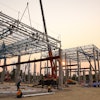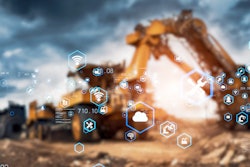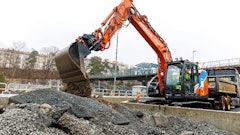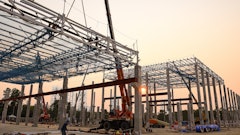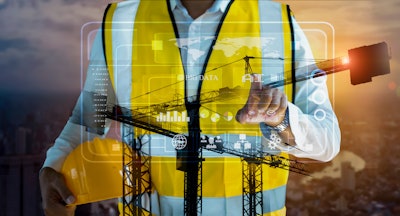
The construction industry is poised for a $4.2 trillion expansion over the next 15 years. But there’s a catch: a growing skills gap, with job vacancies already up 41% year-over-year, and looming retirements threatening to worsen the shortage of qualified professionals.
This is where artificial intelligence (AI) steps in, not just as a futuristic technology, but a practical solution, seamlessly integrating into Contech applications to streamline project design, construction and management. Think of it as the industry’s “spell check” and “auto correct,” boosting efficiency and empowering professionals to bridge the skills gap and capitalize on this period of unprecedented growth.
Breaking Down Data Silos: The Power of Connected Intelligence
One of the most persistent obstacles to efficiency is the prevalence of data silos. A 2024 study highlighted the extent of this issue, revealing that construction workers spend a significant portion of their time – 18% – simply searching for information. Furthermore, 43% of those surveyed believe that improved access to data would directly enhance their decision-making capabilities.
AI offers a powerful remedy to this challenge. By connecting disparate data sources and converting raw information into actionable insights, AI empowers teams with the knowledge they need to make informed decisions, optimize resource allocation, and proactively manage risks. This translates to a more efficient, data-driven approach to project management and business outcomes.
AI Across the Construction Lifecycle: From Preconstruction to Operations
The influence of AI is not confined to a single phase of a construction project; rather, it extends across the entire lifecycle, offering benefits at every stage. In the preconstruction phase, AI is already proving invaluable for conducting feasibility studies, optimizing material selection and procurement and generating precise cost estimations. AI is being used to automate quantity takeoffs and accelerate the estimation process as the project progresses. AI is also streamlining design by automating tasks such as blueprint analysis. AI image generation can identify structural elements (doors, windows, walls, etc.) and estimate costs, replacing manual, error-prone processes that often led to inaccurate estimates. While project managers should always verify AI-generated figures, this technology represents a significant leap towards faster, more precise cost estimations.
From an operational perspective, AI provides real-time progress tracking, enabling project managers to stay informed and proactively address potential delays. Predictive analytics, powered by AI, allows teams to anticipate and mitigate risks before they escalate into costly problems.
Even after project completion, AI continues to deliver value through advanced capabilities like predictive maintenance schedules and energy monitoring systems. These tools optimize operational efficiency, reduce long-term costs and contribute to more sustainable building practices.
The Accelerating Adoption of AI: A Convergence of Factors
The industry has reached an inflection point in its technological evolution, mirroring a pattern seen in other sectors. This evolution has progressed from standalone point solutions to first-generation platforms, and now to truly intelligent platforms that synchronize activities across the project lifecycle and empower teams with predictive capabilities.
This accelerated growth is fueled by three fundamental shifts:
Cost Pressures and Labor Shortages: The increasing need for efficiency improvements in the face of rising costs and labor scarcity has made AI-powered solutions increasingly attractive. Cost control remains a primary motivator, as AI can identify potential cost overruns early on and optimize resource allocation throughout the project lifecycle. For example, studies estimate that AI-powered predictive analytics can reduce project costs by up to 15%.
Breaking Down Data Silos: Recognizing the limitations of fragmented information, companies are actively working to break down data silos and foster greater cross-team collaboration. This movement towards data integration is creating a fertile ground for AI adoption, as it provides the necessary foundation for AI algorithms to effectively analyze and interpret project data.
Democratization of AI Tools: The increasing accessibility of AI tools has played a crucial role in driving adoption. As AI technology becomes more user-friendly and affordable, it is within reach of a wider range of construction firms, regardless of size or technical expertise.
Reimagining the Business of Construction
Unlike manufacturing, which often takes place in controlled environments, construction projects are complex ecosystems with a myriad of variables ranging from unpredictable weather conditions and evolving regulatory requirements to the involvement of multiple stakeholders with often competing priorities.
AI offers a powerful tool to navigate this complexity and enhance key aspects of construction operations.
Enhanced Safety: Safety is paramount in construction, and AI offers significant potential to improve safety outcomes. By analyzing historical data and real-time conditions, AI algorithms can predict potential risks, monitor equipment performance for early signs of failure, and proactively detect hazards on the jobsite. This proactive approach can lead to fewer accidents and a safer work environment for all involved.
Streamlined Planning and Design: AI can significantly enhance the efficiency of planning and design processes. By enabling rapid evaluation of different schedule scenarios, streamlining design iterations, and providing comprehensive analysis of 3D models, AI empowers project teams to optimize designs and identify potential clashes or issues before they become costly problems during construction.
Increased Productivity: Integrating AI into construction workflows can lead to substantial productivity gains. Streamlined material procurement processes, optimized resource allocation and predictive maintenance schedules help minimize downtime and keep projects on track. Moreover, quality control is elevated through meticulous design analysis, the increasing use of robotic precision in construction tasks, and AI-powered inspections, resulting in higher-quality finished products.
The Future of AI in Construction: Connection, Intelligence, Orchestration
The future of AI in construction is brimming with potential. While the adoption of the technology continues to increase, the journey from initial implementation to true transformation hinges on three critical factors:
Connection: Breaking down data silos is essential to create a unified view of projects and portfolios, connecting teams around shared information and fostering seamless collaboration.
Intelligence: Leveraging historical data and real-time information to power predictive analytics is key to identifying potential risks before they materialize and recommending optimal solutions to keep projects on track and within budget.
Orchestration: Synchronizing activities across the entire construction ecosystem, from design and planning to construction and operations, ensures that all parties work together effectively according to central project goals, with real-time visibility into changes and potential challenges.
This continued growth will be driven by the increasing integration of AI with other advanced technologies, such as BIM and robotics, creating a synergistic ecosystem of innovation. Most importantly, the focus remains on augmenting human expertise, empowering teams with powerful AI tools to enhance their capabilities, improve decision-making, and drive innovation across the industry.
As AI technology continues to evolve, it is poised to make an even greater impact on how teams achieve their safety, efficiency and sustainability goals. To fully benefit from these advancements, organizations should invest in AI training for their workforce and actively pilot AI-powered solutions on key projects. The future of construction is intelligent, and those who embrace AI today will be best positioned to lead the way and shape the industry's future.


